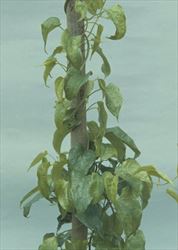- Narrow. Africa, South America, Caribbean. NOT recorded from Oceania.
- Major virus disease of cultivated yams causing yellow/green patterns (mosaics), vein-banding, distortions on leaves, stunting, and lower tuber yield. Sometimes, sets slow to sprout, poor vigour and long, thin leaves giving ‘shoe-string’ symptom. Symptoms may disappear with age.
- Spread: aphids by flight and on the wind. Transmission in non-persistent manner - aphids acquire YMV quickly, transmit it over next few hours, then lose ability to infect. Spreads also in sets for propagation.
- Biosecurity: risk from different strains; unofficial introductioins, and trade in tubers. Official movement of germplasm should always follow the FAO/IPBGR Technical Guidelines.
- Biocontrol: none.
- Cultural control: choose only healthy (largest) tubers for sets; rogue plants that show early YMV symptoms to prevent them being used as sets next season. Weed to remove aphid infestations; collect and destroy or eat undersized tubers at harvest. Resistant lines may be available through international breeding programs.
- Chemical control: not appropriate for this disease.
Pacific Pests, Pathogens and Weeds - Online edition
Pacific Pests, Pathogens, Weeds & Pesticides
Yam mosaic virus disease (526)
Yam mosaic disease
Yam mosaic virus. The virus belongs to the Potyviridae, genus Potyvirus. The virus particles are flexuous rods. The abbrviation is YMV.
AUTHOR Grahame Jackson
Information from CABI (2021) Yam mosaic virus. Crop Protection Compendium (https://www.cabi.org/cpc/datasheet/57255); and Asala S, et al. (2012) Distribution and incidence of viruses infecting yam (Dioscorea spp.) in Nigeria. GJBB, 1(2): 163-167. (https://www.google.com.au/webhp?sourceid=chrome-instant&ion=1&espv=2&ie=UTF-8 - sourceid=chrome-psyapi2&ie=UTF-8&q=Distribution and incidence of viruses infecting yam). Brunt AA, et al. (eds) (1989) FAO/IBPGR Technical Guidelines for the Safe Movement of Yam Germplasm. Food and Agriculture Organization of the United Nations, Rome/International Board for Plant Genetic Resources, Rome. (http://ecoport.org/Resources/Refs/IPGRI/yam.pdf); and Eni AO, et al. (2008) Survey of the incidence and distribution of five viruses infecting yams in the major yam-producing zones in Benin. Annals of Applied Biology, 153: 223-232. (http://covenantuniversity.edu.ng/Profiles/Eni-Angela/Survey-of-the-incidence-and-distribution-of-five-viruses-infecting-yam-in-the-major-yam-producing-zones-in-Benin); and Legg JP, et al.(Undated) Virus diseases of root crops in Africa: an overview. FAO, Rome. (http://www.fao.org/docs/eims/upload/agrotech/2005/sistrc_04_legg.pdf); and Offei SK (Undated) Virus and viral diseases of sub-Saharan Africa: analysis of responses to questionnaires by scientists in sub-Saharan Africa.(https://www.google.com.au/webhp?sourceid=chrome-instant&ion=1&espv=2&ie=UTF-8 - q=virus+diseases+of+yam+crops+in+africa); and Séka K, et al. (2014) Yield loss caused by yam mosaic virus (YMV) and cucumber mosaic virus (CMV) on the varieties of Dioscorea spp. International Journal of Agronomy and Agricultural Research, 5(2): 64-71. (https://www.google.com.au/webhp?sourceid=chrome-instant&ion=1&espv=2&ie=UTF-8 - q=Yield+loss+caused+by+yam+mosaic+virus+(YMV)+and+cucumber); and Umber M, et al. (2020) Molecular virus diagnostics and sanitation of yam genetic resources: Implications for safe yam germplasm exchange. Viruses 12: 1101. (https://www.mdpi.com/1999-4915/12/10/1101); and Lopes-Montes A, et al. (2012) Yam breeding at IITA: achievements, challenges, and propsects. Research for development review. (https://biblio1.iita.org/bitstream/handle/20.500.12478/1579/U12ArtLopezmontesYamNothomNodev.pdf?sequence=1&isAllowed=y/); and from Luo GF, et al. (2022) A review of viruses infecting yam (Disoscoea spp): implications for safe exchange of Pacific yam germplasm. Viruses 14(4): 662. (https://doi.org/10.3390/v14040662). Photos 1-3 Yam infected by yam mosaic virus. IITA. ( https://www.flickr.com/photos/iita-media-library/4907182850/in/photolist-8tCAuG-8tFeQC-8tCAuU-8tCAuA-8tCAuS-83SAoU-8tFeQA-cngRqm/), (https://www.flickr.com/photos/iita-media-library/4907698686/in/photolist-8tCAuG-8tFeQC-8tCAuU-8tCAuA-8tCAuS-83SAoU-8tFeQA-cngRqm/), and (https://www.flickr.com/photos/iita-media-library/4907182852/in/photolist-8tCAuG-8tFeQC-8tCAuU-8tCAuA-8tCAuS-83SAoU-8tFeQA-cngRqm/).
Produced with support from the Australian Centre for International Agricultural Research under project HORT/2016/185: Responding to emerging pest and disease threats to horticulture in the Pacific islands, implemented by the University of Queensland, in association with the Pacific Community.







